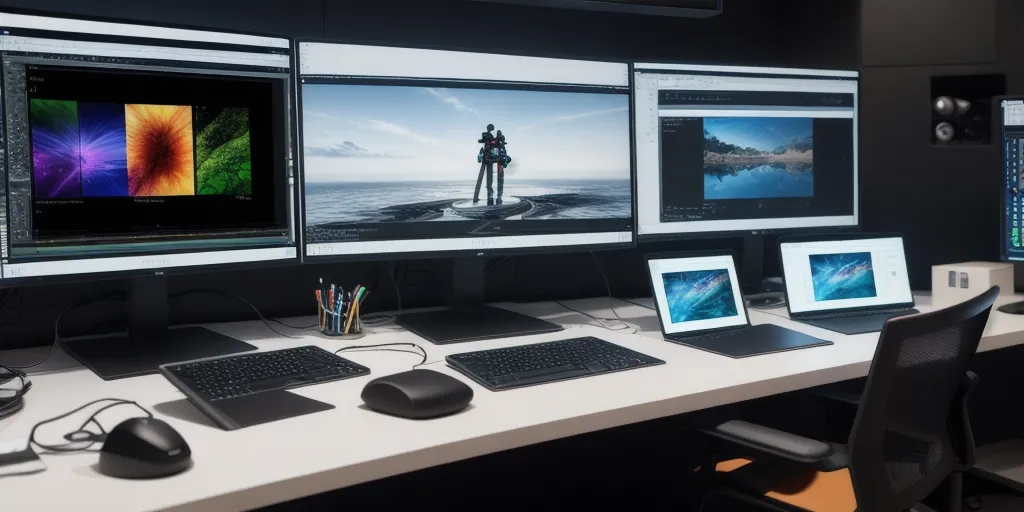To create realistic AI videos, you will need to utilize advanced artificial intelligence technology and video editing software. Start by gathering high-quality video footage or images that you want to use in your AI video. Next, choose a reliable AI video editing tool that offers features such as deep learning algorithms, facial recognition, and object tracking.
These tools can help you enhance the realism of your video by adding special effects, adjusting lighting, and improving overall visual quality.
Additionally, consider using AI voice synthesis technology to create realistic voiceovers for your video. This can help make your AI video more engaging and immersive for viewers. Finally, pay attention to details such as color grading, sound effects, and transitions to ensure that your AI video looks and sounds as realistic as possible.
By following these steps and utilizing the latest AI technology, you can create stunning and lifelike AI videos that will captivate your audience.
What tools are needed to create realistic ai videos?

Creating realistic AI videos requires a combination of specialized tools and software to achieve a high level of realism. One essential tool is a powerful computer with a high-performance graphics card to handle the complex calculations required for rendering lifelike visuals.
Additionally, software programs such as Adobe After Effects or Blender are commonly used to create and edit the AI-generated content. These programs offer a wide range of features and effects that can enhance the realism of the videos, such as motion tracking, compositing, and visual effects.
Another important tool is a high-quality camera or webcam to capture the initial footage that will be used as a base for the AI-generated content. Lighting equipment is also crucial to ensure that the lighting in the video matches the AI-generated elements seamlessly.
Finally, access to a reliable internet connection is necessary for downloading AI models and updates to the software. By utilizing these tools effectively, creators can produce AI videos that are indistinguishable from reality.
How can ai voice synthesis enhance the realism of videos?

AI voice synthesis can greatly enhance the realism of videos by providing more natural and human-like voices to the characters or narrators in the content. This technology allows for the creation of high-quality audio that closely mimics the nuances and intonations of human speech, making the viewing experience more immersive and engaging for the audience.
By using AI voice synthesis, video creators can easily generate voiceovers in multiple languages or dialects, without the need for hiring voice actors or recording studios. This not only saves time and resources but also opens up new possibilities for reaching a global audience.
Additionally, AI voice synthesis can be used to improve accessibility in videos by providing audio descriptions for visually impaired viewers or generating subtitles in real-time.
Overall, the integration of AI voice synthesis in videos can elevate the production value, increase viewer engagement, and make the content more inclusive and accessible to a wider range of audiences.
Why is it important to pay attention to details like color grading in ai videos?

Paying attention to details like color grading in AI videos is crucial for several reasons. Firstly, color grading plays a significant role in setting the mood and tone of a video. By adjusting the colors and contrast, filmmakers can evoke specific emotions and create a more immersive viewing experience for the audience.
This is especially important in AI videos, where the visuals are often the main focus of the content. Additionally, proper color grading can enhance the overall quality and professionalism of a video, making it more visually appealing and engaging.
It can also help maintain consistency throughout the video, ensuring that all scenes flow seamlessly together. Furthermore, color grading can help highlight important elements or subjects in a video, directing the viewer’s attention to key points.
Overall, paying attention to details like color grading in AI videos is essential for creating high-quality, impactful content that resonates with viewers and effectively conveys the intended message. By carefully considering and adjusting the colors in a video, content creators can elevate the overall production value and enhance the viewing experience for their audience.
What features should a reliable ai video editing tool offer for realistic videos?

A reliable AI video editing tool should offer a variety of features to ensure that the videos produced are realistic and high-quality. Firstly, the tool should have advanced facial recognition technology to accurately track and edit facial features in the video. This will help in creating seamless transitions and realistic effects.
Additionally, the tool should have a wide range of editing options such as color correction, lighting adjustments, and special effects to enhance the overall look of the video. It should also have the ability to automatically sync audio with video footage to ensure that the sound is in perfect harmony with the visuals.
Furthermore, the tool should offer easy-to-use interface and intuitive controls to make the editing process smooth and efficient. It should also have the capability to render videos in high definition to maintain the realism of the final product.
Overall, a reliable AI video editing tool should offer a comprehensive set of features that cater to the needs of creators looking to produce realistic and professional-looking videos.